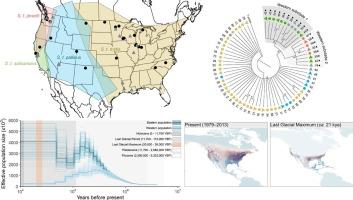The genetic consequences of historic climate change on the contemporary population structure of a widespread temperate North American songbird
IF 3.6
1区 生物学
Q2 BIOCHEMISTRY & MOLECULAR BIOLOGY
引用次数: 0
Abstract
Studies of widely distributed species can inform our understanding of how past demographic events tied to historic glaciation and ongoing population genetic processes interact to shape contemporaneous patterns of biodiversity at a continental scale. In this study, we used whole-genome resequencing to investigate the current population structure and genetic signatures of past demographic events in the widespread migratory American goldfinch (Spinus tristis). Phylogenetic relationships inferred from whole mitochondrial genomes were poorly resolved. In contrast, a genome-wide panel of > 4.5 million single nucleotide polymorphisms (SNPs) strongly supported the existence of eastern and western populations separated by western mountain ranges and additional population structuring within the western clade. Demographic modeling estimated that the eastern and western populations diverged approximately one million years ago, and both populations experienced subsequent population bottlenecks during the last glacial period. Species distribution models showed a severe contraction of suitable habitat for the American goldfinch during this period, with predicted discontinuities that are consistent with multiple, isolated glacial refugia that coincide with present-day population structure. Low overall genetic differentiation between the eastern and western populations (FST ∼ 0.01) suggests ongoing gene flow accompanied divergence, and individuals with admixed genomic signatures were sampled along a potential contact zone. Nevertheless, outlier SNPs were identified near genes associated with feather color, song, and migratory behavior and provide strong candidates for further study of the mechanisms underlying reproductive isolation and speciation in birds.

历史性气候变化对北美温带广泛分布的一种鸣禽当代种群结构的遗传影响。
对分布广泛的物种进行研究,可以帮助我们了解与历史性冰川融化相关的过去的人口统计事件和当前的种群遗传过程是如何相互作用,从而在大陆范围内形成当代的生物多样性模式的。在这项研究中,我们利用全基因组重测序技术研究了广泛迁徙的美国金翅雀(Sinus tristis)目前的种群结构和过去人口事件的遗传特征。从全线粒体基因组推断出的系统发育关系并不明确。与此相反,一个由大于 450 万个单核苷酸多态性(SNPs)组成的全基因组面板有力地支持了被西部山脉分隔的东部和西部种群的存在,以及西部支系内额外的种群结构。人口统计模型估计,东部和西部种群大约在一百万年前分化,在上一个冰川期,两个种群都经历了随后的种群瓶颈。物种分布模型显示,在这一时期,美国金翅雀的适宜栖息地严重萎缩,预测的不连续性与多个孤立的冰川避难所一致,而这些避难所与现今的种群结构相吻合。东部和西部种群之间的总体遗传分化程度较低(FST ∼ 0.01),这表明伴随着分化的基因流动仍在继续,而且在潜在的接触带采样到了具有混合基因组特征的个体。然而,在与羽毛颜色、鸣声和迁徙行为相关的基因附近发现了异常SNPs,为进一步研究鸟类的生殖隔离和物种分化机制提供了有力的候选。
本文章由计算机程序翻译,如有差异,请以英文原文为准。
求助全文
约1分钟内获得全文
求助全文
来源期刊
CiteScore
7.50
自引率
7.30%
发文量
249
审稿时长
7.5 months
期刊介绍:
Molecular Phylogenetics and Evolution is dedicated to bringing Darwin''s dream within grasp - to "have fairly true genealogical trees of each great kingdom of Nature." The journal provides a forum for molecular studies that advance our understanding of phylogeny and evolution, further the development of phylogenetically more accurate taxonomic classifications, and ultimately bring a unified classification for all the ramifying lines of life. Phylogeographic studies will be considered for publication if they offer EXCEPTIONAL theoretical or empirical advances.

 求助内容:
求助内容: 应助结果提醒方式:
应助结果提醒方式:


